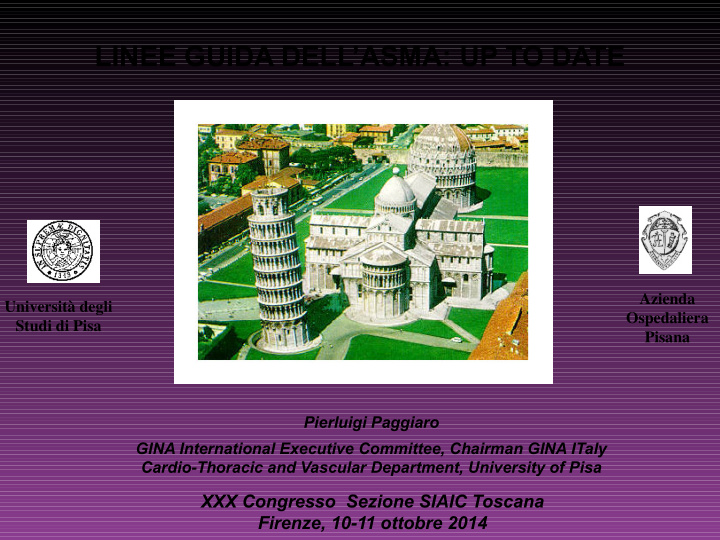



LINEE GUIDA DELL’ASMA: UP TO DATE Azienda Università degli Ospedaliera Studi di Pisa Pisana Pierluigi Paggiaro GINA International Executive Committee, Chairman GINA ITaly Cardio-Thoracic and Vascular Department, University of Pisa XXX Congresso Sezione SIAIC Toscana Firenze, 10-11 ottobre 2014
Bronchial Asthma heterogeneity in clinical presentation Large difference in clinical manifestations, related to: • – Severity of the disease – Heterogeneity of inducers and/or triggers – Level of adherence to therapeutic plan Existance of different phenotypes • – Clinical and functional – Biological Difference in: • – Strategy of asthma treatment
A new definition of asthma (GINA 2014): a heterogeneous disease GINA 2014, draft
Main objectives in asthma treatment: control vs future risk ATS Statement, AJRCCM 2009
Symptom control vs future risk GINA 2014
Bronchial Asthma heterogeneity in clinical presentation Large difference in clinical manifestations, related to: • – Severity of the disease – Heterogeneity of inducers and/or triggers – Level of adherence to therapeutic plan Existance of different phenotypes • – Clinical and functional – Biological Difference in: • – Strategy of asthma treatment
Different asthma phenotypes
Different asthma phenotypes
Asthma phenoypes Eosinophilic vs non-eosinophilic asthma • Eosinophilic phenotype – Allergen-induced asthma, children asthma – Severe asthma with frequent exacerbations (CS- dependent asthma) • Non eosinophilic phenotype – Specific “triggers” (pollutants, endotoxins, chemicals, viruses) – In all asthma severity levels
Absence of sputum eosinophilia in corticosteroid”naive” asthmatics predicts a poor short-term response to ICS Bacci et al, Chest 2006
Steroid-naif symptomatic noneosinophilic asthma may remain stable over 6 months Bacci et al, Respirology 2012
Initial controller treatment GINA 2014
Role of combination therapy GINA 2014
“Maintenance and reliever” strategy reduces asthma exacerbations, as well as or better than traditional strategies Humbert et al, Allergy 2008
Extrafine BDP/F as maintenance and reliever therapy - significantly prolonged time to first severe exacerbation - 36% reduction in the risk of experiencing a severe exacerbation Papi et al, The Lancet Respiratory Medicine, 2013
When and how stepping up GINA 2014
When and how stepping down GINA 2014
When and how stepping down GINA 2014
When and how stepping down GINA 2014
Anticholinergics in asthma • Short-acting anticholinergics in asthma – Less effective than short-acting beta2-agonists – Recommended only in acute severe asthma attack • Tiotropium: – Largely used in COPD • Recent studies on tiotropium in asthma – Since 2007 • Large RCTs with Tiotropium in Asthma (TinA)
First coprimary endopoint (FEV1) Kerstjens et al, NEJM 2012
Third coprimary endopoint (severe exacerbations) Severe exacerbation rate - 21% - Time to first ex: + 56 days - NNT: 15 - Minor changes in symptoms - ACQ7 • -0.09 in trial 1 (n.s.) • -0.13 in trial 2 (p=0.06) - AQLQ • -0.04 in trial 1 (n.s.) • -0.18 in trial 2 (p=0.02) Kerstjens et al, NEJM 2012
Triple therapy in asthma • Combination of ICS, LAMA, LAMA – Different inhalers – Single inhaler (once daily vs twice daily) • Current position – LAMA in addition to ICS/LABA – Which patients ? Future perspectives
The control of sputum eosinophilia is associated with a reduction in asthma exacerbations, but only for eosinophilic exacerbations Jayaram et al, ERJ 2006 Green et al, Lancet 2002
Multiple Levels to Target Novel Therapies 1. Antigen presentation 2. Th-2 cell stimulation and release of Th-2 cytokines 3. Mast cell activation (IgE) 4. Eosinophil recruitment and activation. 5. Upregulation of adhesion molecule expression in blood vessels and epithelium. 6. Activation of resident cells such as fibroblasts.
Italian multicentre observational study in patients under treatment with Omalizumab • 24 Italian pulmonary and allergology centres • More than 300 patients under treatment • Aims: • Evaluation of the level of asthma control (symptoms, pulmonary function, exacerbations) • Factors related to poor asthma control • Relationship «duration of treatment / level of control»
Control of asthma in severe asthmatics treated with omalizumab Novelli et al, Pulm Pharm Ther 2014
Asthma control in severe asthmatics treated with omalizumab Poorly controlled Well-partially controlled Number of patients 75 221 Age, yrs 53,4±13,5 51,5±13,9 Gender, M/F % 34,7/65,3 38/62 Smoke, Y/Ex/No % 4,0/25,3/70,7 3,6/28,1/67,4 Rhinitis, n (%) 51(68,9) 142(65,1) Chronic rhinosinusitis, n (%) 28(38,4) 70(33) Nasal polyps, n (%) 20(27,8) 51(23,6) Aspirin intolerance, n (%) 24(33,8) 39(18,6)* Obesity, n (%) 25(33,3) 43(19,5)* Gastro-oesophageal reflux, n(%) 35(47,3) 69(32,5)* Mental disorders, n (%) 8(11,3) 15(7,1) Months of OT 29,5(4-96) 33(4-120) Pre-BD FEV1, % del predetto 64,1±19,8 78,3±19,7* * p<0.05 Novelli et al, Pulm Pharm Ther 2014
Exacerbations in severe asthmatics treated with omalizumab No exacerbations Exacerbations ≥1 Number of patients 167 125 Age, yrs 51,6±13,2 52,5±14,4 Gender, M/F 39,5/60,5 34,4/65,6 Smoke, Y/Ex/No 3,6/28,1/67,1 3,2/25,6/71,2 Rhinitis, % 108(65,9) 80(64,5) Chronic rhinosinusitis, % 43 (27) 52 (43,3)* Nasal polyps, % 30 (18,5) 43 (35,2) 3 * Aspirin intolerance, % 25(15) 35(29,4) 5* Obesity, % 28(16,9) 38 (30,4)* Gastro-oesophageal reflux, % 47 (29,4) 55(45,1)* Mental disorders, % 10(6,3) 11 (9,2) Months of omalizumab 32 (5-79) 36 (4-120) Pre-BD FEV1, % del predetto 77,8±18,6 70,6±22,4* ACT score 22 (10-25) 20 (6-25)* Novelli et al, Pulm Pharm Ther 2014 * p<0.05
Asthma control in patients without comorbidities Novelli et al, Pulm Pharm Ther 2014
Duration of omalizumab treatment may be associated with a better asthma control * * p=0.003 Novelli et al, Pulm Pharm Ther 2014
Different targets for intervention on the «inflammatory cascade» Gallelli et al, Biomed Res Int 2013
Pelaia et al, Nature Rev 2012
Castro et al, AJRCCM 2010
Asthma: a heterogeneous disease • Identification of different phenotypes – According to etiology – According to pathogenesis – According to severity • Implication for treatment – With current drugs – With biologic drugs – With allergen-immunotherapy – With thermoplasty
Recommend
More recommend